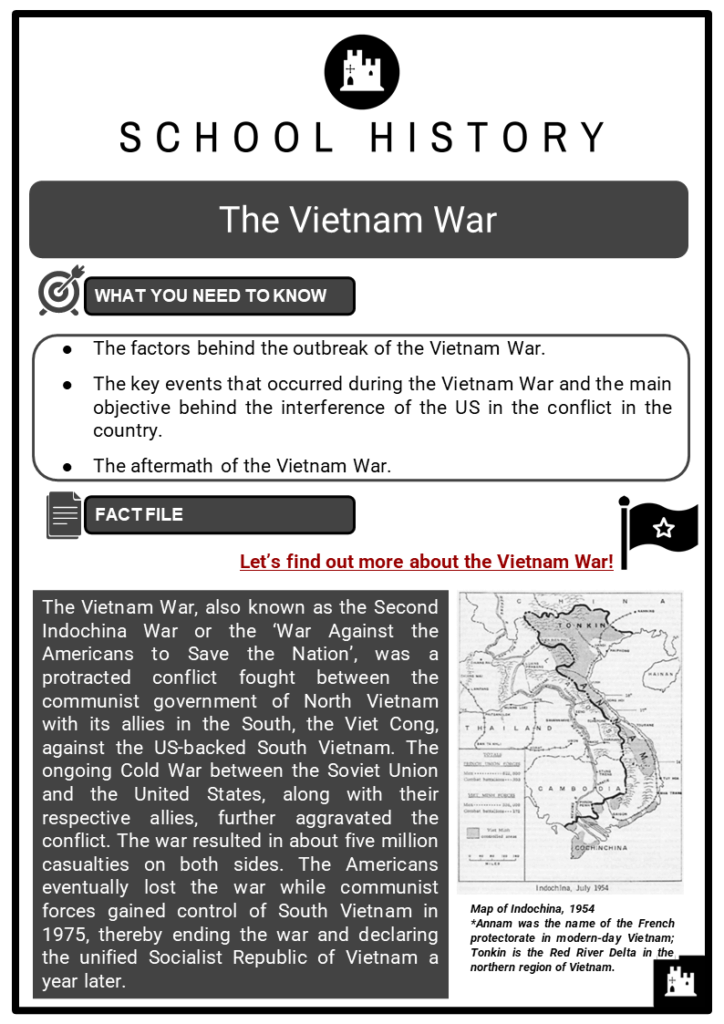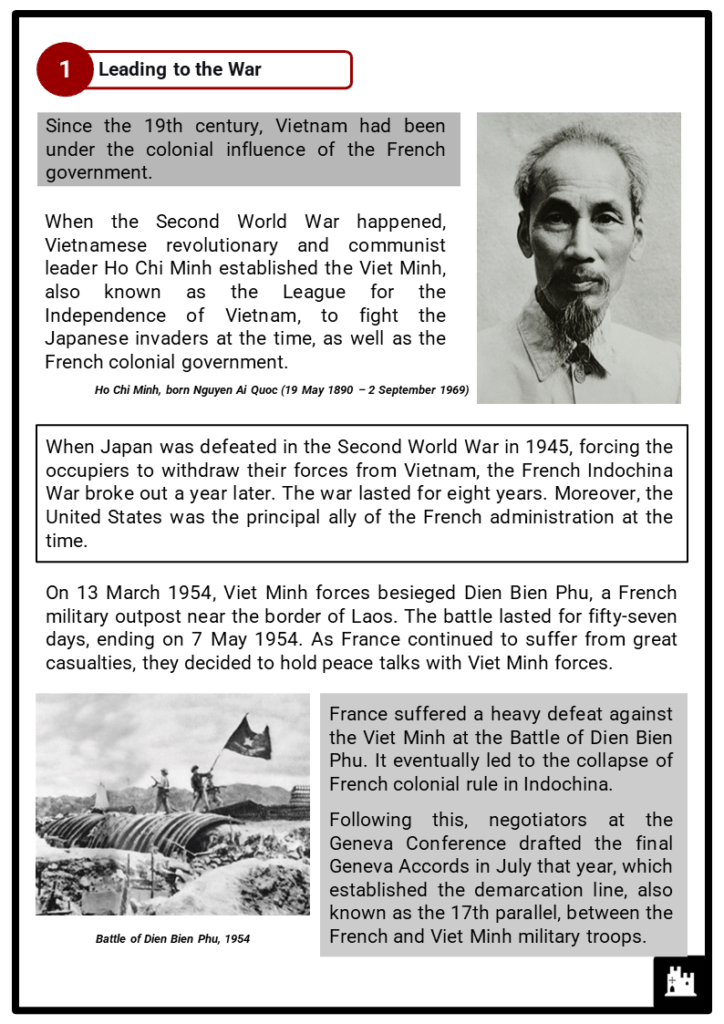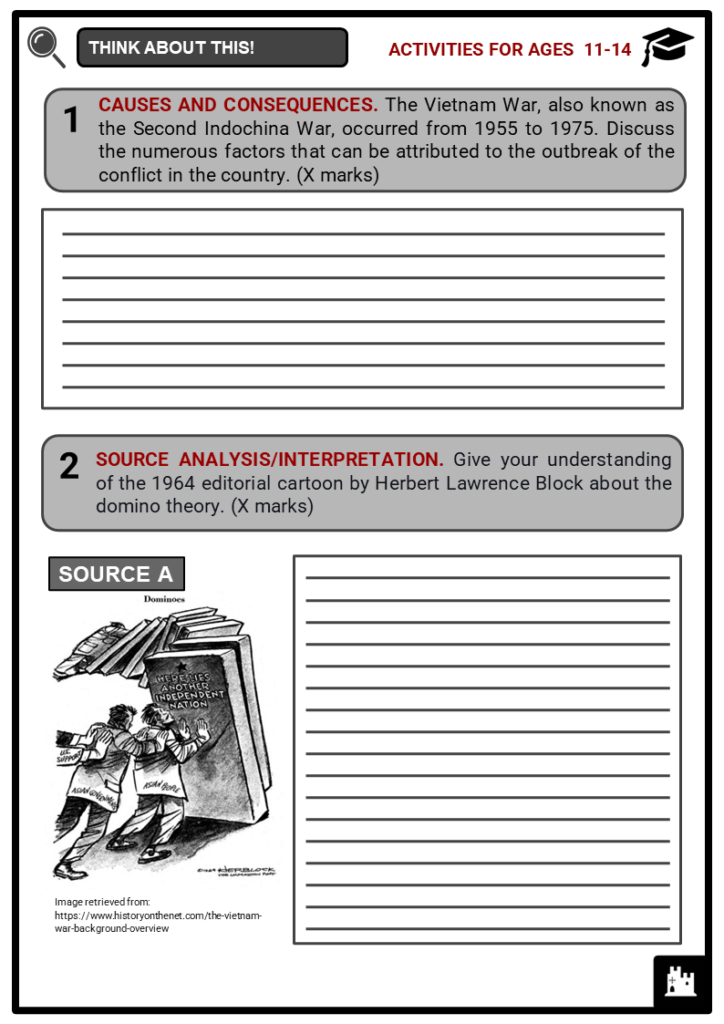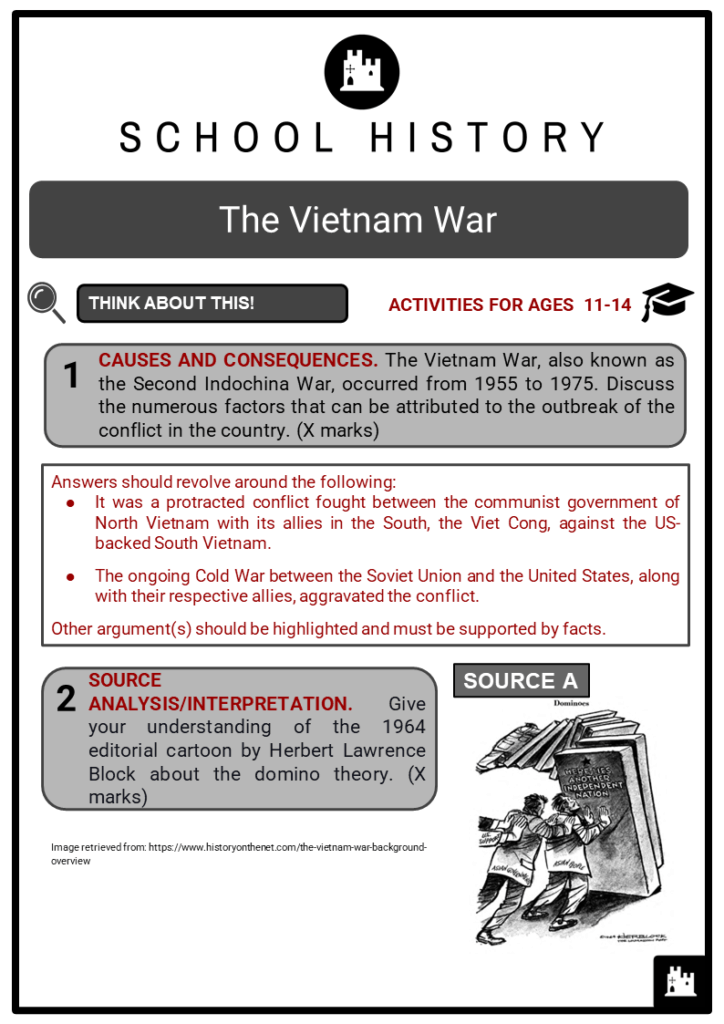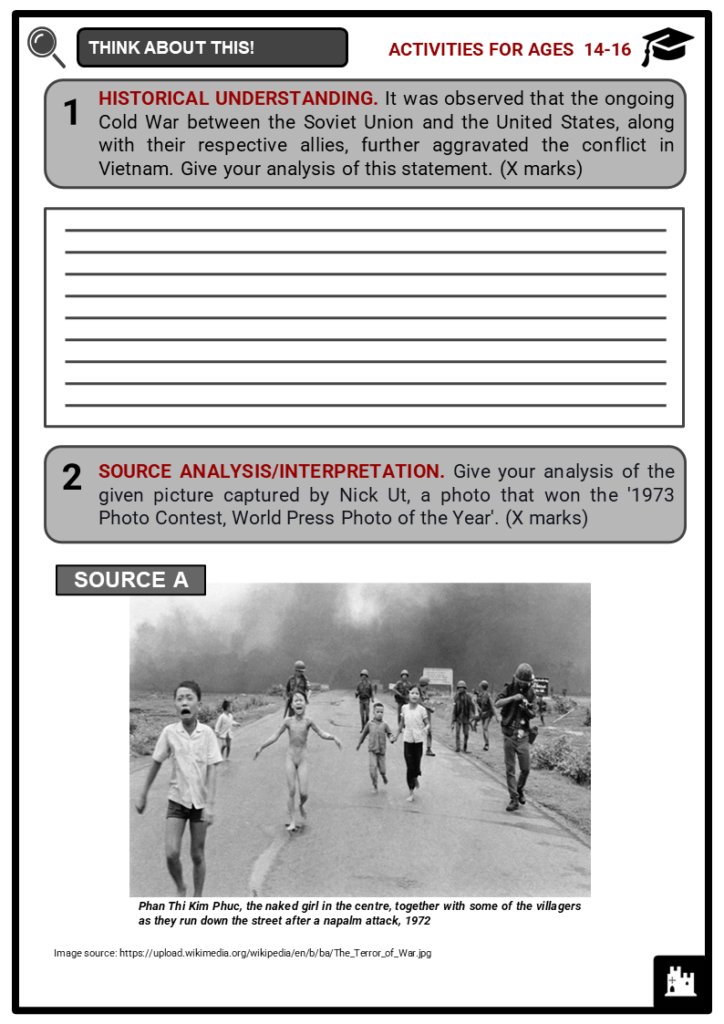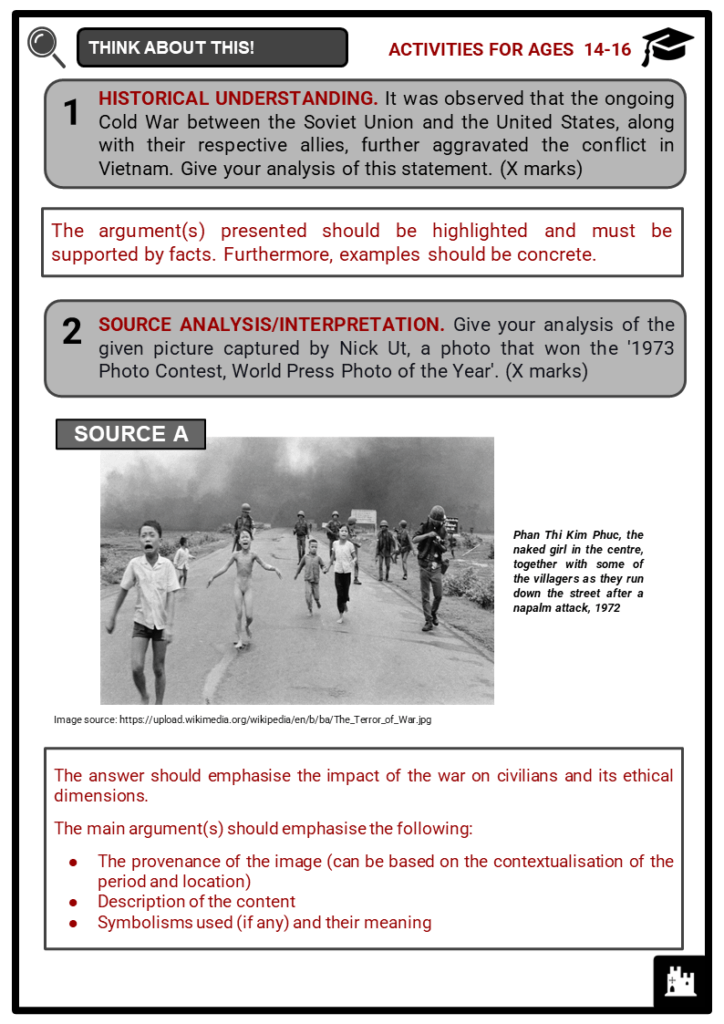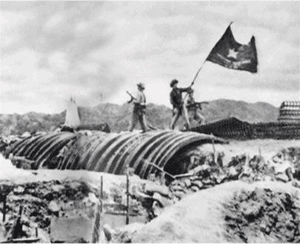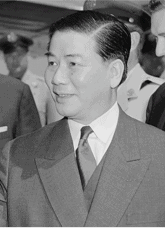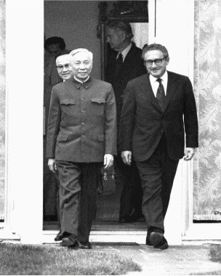Download The Vietnam War Worksheets
Do you want to save dozens of hours in time? Get your evenings and weekends back? Be able to teach The Vietnam War to your students?
Our worksheet bundle includes a fact file and printable worksheets and student activities. Perfect for both the classroom and homeschooling!
Table of Contents
Add a header to begin generating the table of contents
Summary
- The factors behind the outbreak of the Vietnam War.
- The key events that occurred during the Vietnam War and the main objective behind the interference of the US in the conflict in the country.
- The aftermath of the Vietnam War.
Key Facts And Information
Let’s find out more about the Vietnam War!
- The Vietnam War, also known as the Second Indochina War or the ‘War Against the Americans to Save the Nation’, was a protracted conflict fought between the communist government of North Vietnam with its allies in the South, the Viet Cong, against the US-backed South Vietnam. The ongoing Cold War between the Soviet Union and the United States, along with their respective allies, further aggravated the conflict. The war resulted in about five million casualties on both sides. The Americans eventually lost the war while communist forces gained control of South Vietnam in 1975, thereby ending the war and declaring the unified Socialist Republic of Vietnam a year later.
Leading to the War
- Since the 19th century, Vietnam had been under the colonial influence of the French government.
- When the Second World War happened, Vietnamese revolutionary and communist leader Ho Chi Minh established the Viet Minh, also known as the League for the Independence of Vietnam, to fight the Japanese invaders at the time, as well as the French colonial government.
- When Japan was defeated in the Second World War in 1945, forcing the occupiers to withdraw their forces from Vietnam, the French Indochina War broke out a year later. The war lasted for eight years. Moreover, the United States was the principal ally of the French administration at the time.
- On 13 March 1954, Viet Minh forces besieged Dien Bien Phu, a French military outpost near the border of Laos. The battle lasted for fifty-seven days, ending on 7 May 1954. As France continued to suffer from great casualties, they decided to hold peace talks with Viet Minh forces.
- France suffered a heavy defeat against the Viet Minh at the Battle of Dien Bien Phu. It eventually led to the collapse of French colonial rule in Indochina.
- Following this, negotiators at the Geneva Conference drafted the final Geneva Accords in July that year, which established the demarcation line, also known as the 17th parallel, between the French and Viet Minh military troops.
- The northern region became the territory of the Democratic Republic of Vietnam (DRV), with the city of Hanoi as its capital. The North was led by the Workers Party, also known as the Vietnamese Communist Party, with Ho as its president. South of the line was the State of Vietnam, with the city of Saigon as its capital. Former Vietnamese emperor Bao Dai became its nominal leader.
- The nationwide elections (which were due to be held in 1956) were supposed to be the reunification of Vietnam. The Americans, however, refused for the country to become a communist ally, thus helped Ngo Dinh Diem to be elected as president of South Vietnam.
The War
- As the Cold War intensified, the Americans continued their counter-revolutionary policies against communist allies and sympathisers. Following this, US President Dwight Eisenhower declared his full support to Diem and South Vietnam in 1955. Diem led a crackdown against Vietnamese communists in the South, also called the Viet Cong. Around 100,000 people were detained, tortured and executed.
- In 1957, the resistance against Diem’s oppressive regime emerged, as led by the Viet Cong. By 1959, they began fighting South Vietnamese military forces via firefights.
- Additionally, revolutionaries in the South established the National Liberation Front (NLF) in December 1960 to organise resistance against the rule of Diem.
- Fearing that several countries would follow if one Southeast Asian country became communist, also dubbed as the domino theory, US President John F. Kennedy increased US military forces in South Vietnam to defeat the Viet Cong. By 1962 there were approximately 9,000 American military troops in the South.
- Three weeks before the assassination of JFK, Diem and his brother Ngo Dinh Nhu were killed by a coup established by Diem’s own generals in November 1963. The incident led Lyndon B. Johnson, Kennedy’s successor, to provide more US military presence in South Vietnam.
- Following the attack of North Vietnam against two US destroyers anchored in the Gulf of Tonkin in August 1964, Congress passed the Gulf of Tonkin Resolution, which gave Johnson further war-making powers, thereby declaring war against North Vietnam.
- Consequently, Johnson launched a bombing campaign named Operation Rolling Thunder. The bombing raids not only targeted DRV but also neighbouring countries like Laos to hamper the flow of war supplies along the Ho Chi Minh trail and halt the emergence of Lao communist sympathisers.
- By 1967, US military troops in South Vietnam had gone up to 500,000.
- On 31 January 1968, North Vietnam executed a surprise attack, known as the Tet Offensive, which destroyed around 100 cities in South Vietnam and left thousands of casualties on both sides.
- On 11-17 February of that year, 543 US soldiers died, the highest recorded number of US casualties at the time.
- On 6 March 1968, American forces massacred 400 unarmed civilians during their search and destroy operations in the village of My Lai.
- US troops killed hundreds of unarmed civilians in the Sơn Tịnh District, South Vietnam, during a four-hour assault. The areas, tagged on US maps as Mỹ Lai and Mỹ Khê, were attacked by US troops and the majority of the victims were children and women. The incident was part of a search and destroy tactic. Twenty-six soldiers were charged but only Lieutenant William Calley Jr. was convicted.
- When the incident went public in November 1969, as the Pinkville Massacre, it sparked global outrage and the US’s involvement in the Vietnam War was condemned. This massacre resulted in massive anti-war protests. On 15 November 1969 more than 250,000 Americans demonstrated in Washington, D.C., the largest ever recorded demonstration in US history.
- On 4 May 1970, during an anti-war protest at Kent State University, the National Guardsmen shot a group of college demonstrators, which left four students killed and nine others wounded.
- The students of Kent State University protested against the US government due to Nixon’s declaration of a bombing campaign in Cambodia. The incident stirred a national response as four million students from high schools, colleges and universities throughout the United States organised student strikes condemning the US government’s involvement in the Indochinese conflict.
- In June of that year, Congress repealed the Gulf of Tonkin Resolution, thus limiting the war-making powers of the president. For this reason, President Richard Nixon declared the withdrawal of US soldiers from Vietnam.
Aftermath
- On 27 January 1973, North Vietnam and the United States finally came to an agreement after President Nixon signed the Paris Peace Accords, thereby withdrawing US military forces in Vietnam.
- The war between North and South Vietnam continued but eventually came to an end on 30 April 1975 when communist forces defeated the South and seized control of Saigon, which was later renamed Ho Chi Minh City.
- Prior to its establishment, peace talks between the US and North Vietnam had already been settled in October 1972. North Vietnamese representatives and Henry Kissinger, the US National Security Advisor, negotiated and composed a treaty that would end the Vietnam War. However, Nguyen Van Thieu, the President of South Vietnam, fearing the withdrawal of US troops from his country, refused to sign the peace agreement. Nixon threatened that the US would continue bombing raids if they refused to sign. On the other hand, Kissinger offered peace terms.
- By January 1973, the Paris Peace Accords were signed between Kissinger as the US negotiator and Le Duc Tho, a member of the Vietnamese Communist Party Politburo. A ceasefire was agreed and the US would withdraw its troops. Both negotiators won the 1973 Nobel Peace Prize but Le Duc Tho refused to accept it.
- The warfare devastatingly resulted in approximately two million Vietnamese deaths. Furthermore, around three million were wounded and about 12 million became refugees. It likewise destroyed Vietnam’s economy and infrastructure that took years to reconstruct.
- Numbers:
- 58,000 Americans were killed during the Vietnam War and 700,000 veterans were affected.
- Around 1,000,000 to 4,000,000 Vietnamese were killed. Furthermore, many Vietnamese suffered from exposure to chemicals used by the US. They brought diseases and psychological trauma, which persisted for a long time.
- The United States spent around $100,000,000,000 on the Vietnam War.
- After the Fall of Saigon, between 200,000 to 300,000 Southern Vietnamese were sent to re-education camps under the communist government.
- On 2 July 1976, a new constitution was adopted by Vietnam ratifying the country as the Socialist Republic of Vietnam.
- The Presidential Palace was renamed the Independence Palace and 30 April is celebrated in Vietnam as Reunification Day.
- The country became the unified Socialist Republic of Vietnam in 1976, even though conflicts with China and Cambodia continued over the next 15 years.
- Vietnam’s economy began improving in 1986 via a free market policy, allowing further oil export revenues and increased foreign capital. In the 1990s, diplomatic and trade affairs between the United States and Vietnam were reestablished.
- Due to its 120 billion dollar expenditure on the Vietnam War from 1965 to 1973, the United States suffered widespread inflation, which was aggravated by a worldwide oil crisis in 1973.
Image sources:

